Abstract
Mouse tumor necrosis factor (TNF) was purified from serum through a series of steps, and each step was monitored for L-cell cytotoxicity in vitro and tumor-necrotizing activity in vivo. The two activities copurified and could not be dissociated. Purified mouse TNF has a specific activity of 2.2 X 10(7) (L-cell assay in the absence of actinomycin D) and 1 microgram causes necrosis of the standard TNF-sensitive sarcoma Meth A. TNF has a Mr of 39,000 +/- 2000 by gel filtration and a Mr of 16,000-18,000 by NaDodSO4/PAGE. Both molecular weight forms display cytotoxic and necrotizing activities. TNF has a pI of 3.9 and is destroyed by trypsin, protease, elastase, and alpha-chymotrypsin but not by neuraminidase or papain. These characteristics of nonrecombinant mouse TNF clearly resemble those of recombinant human and mouse TNF.
Full text
PDF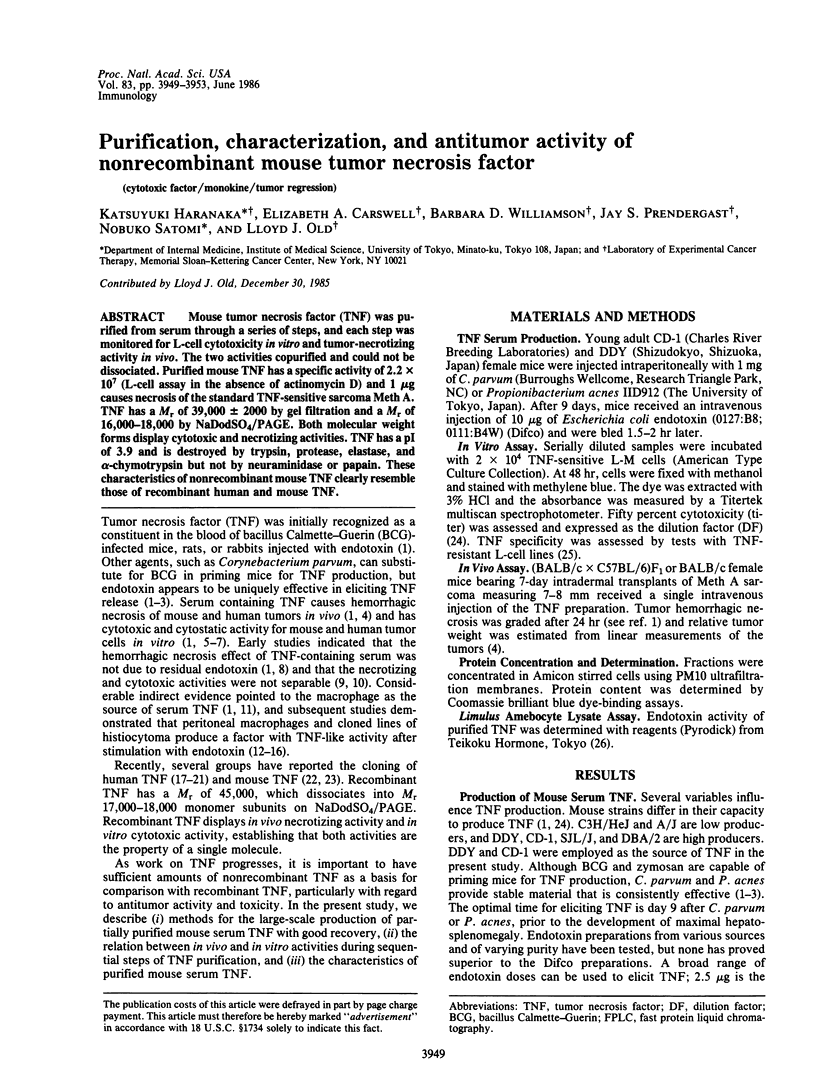
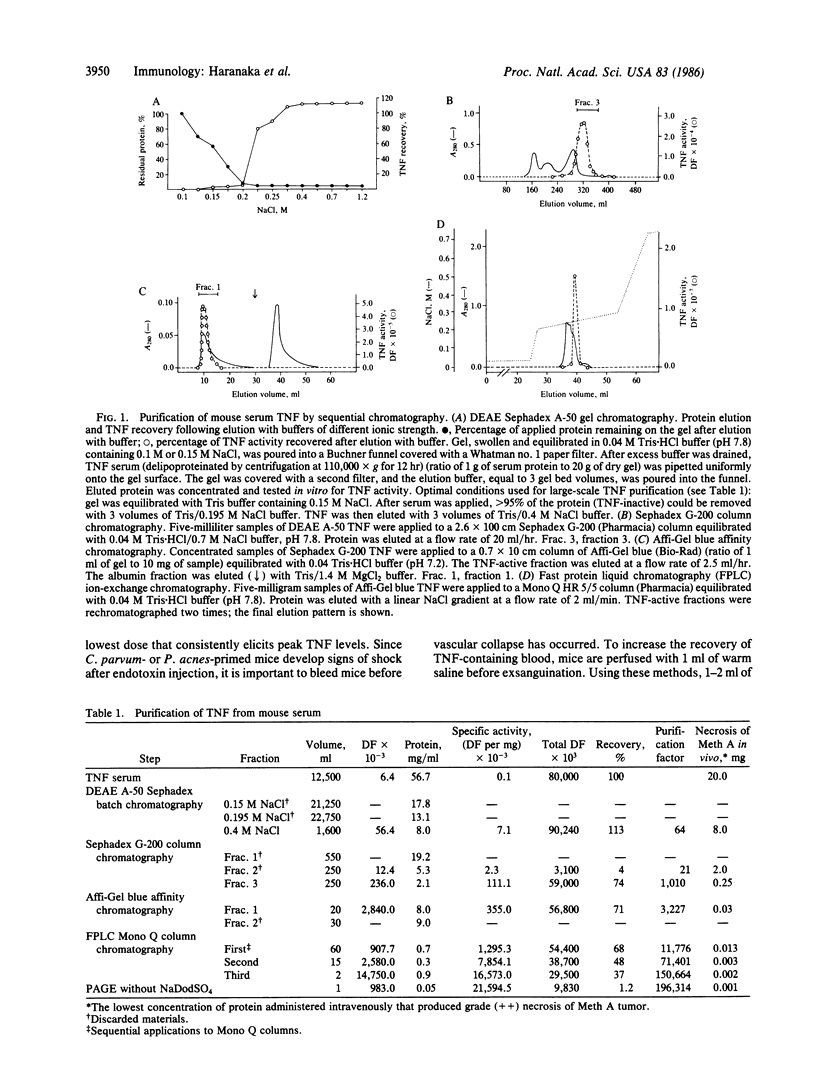
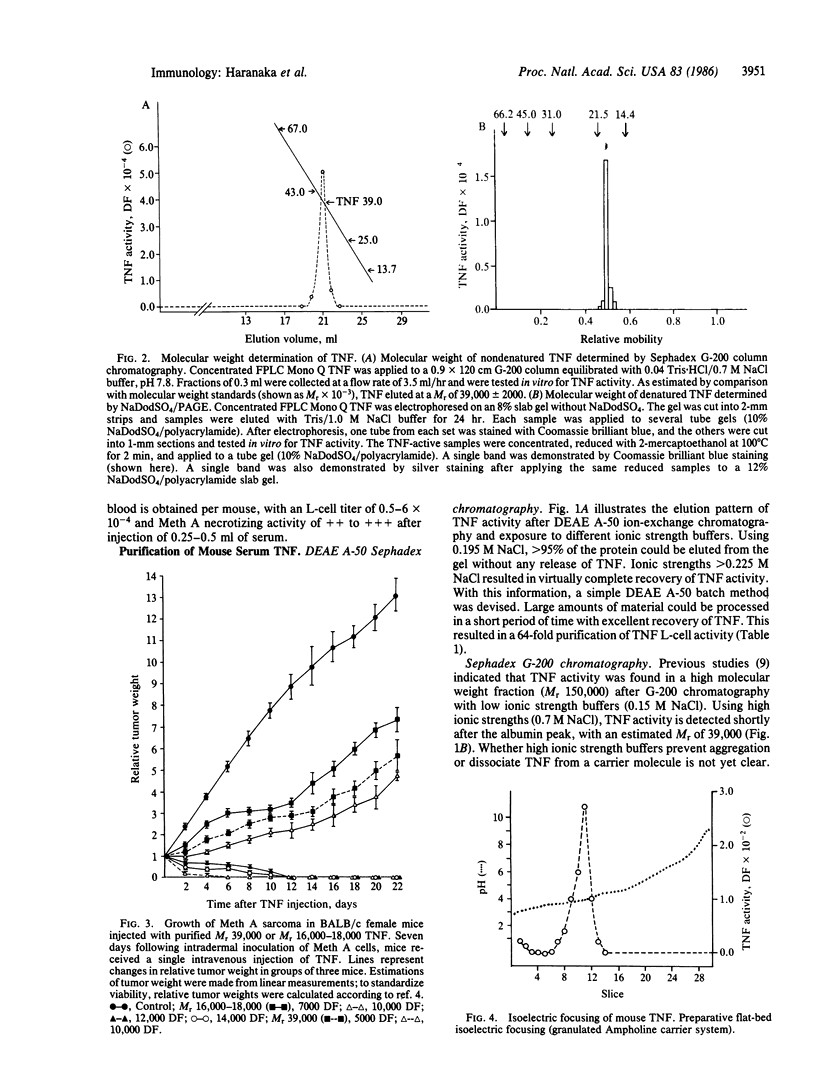
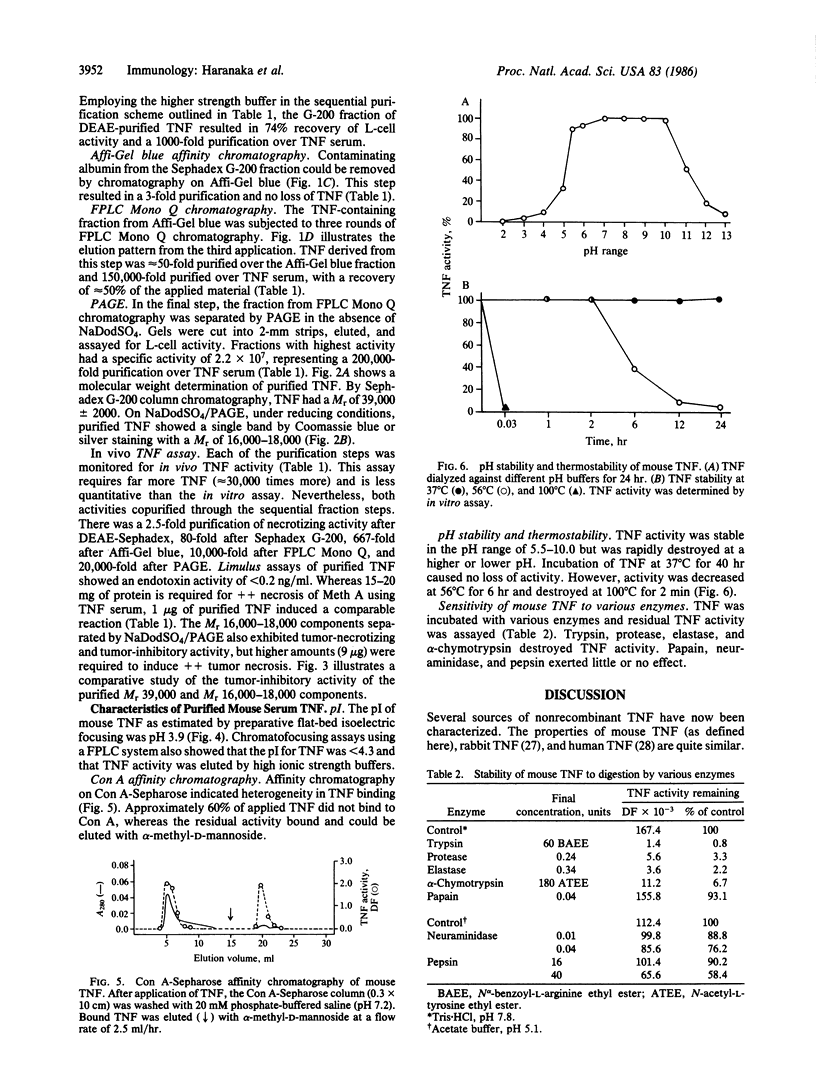
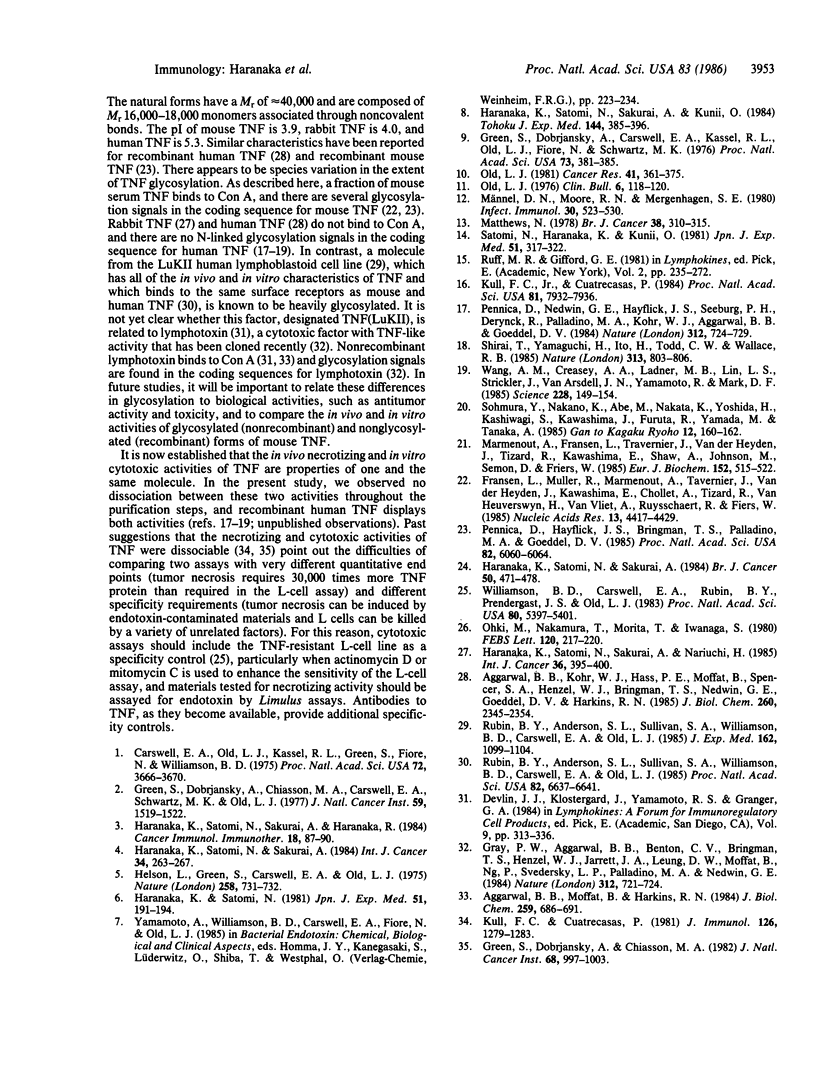
Images in this article
Selected References
These references are in PubMed. This may not be the complete list of references from this article.
- Aggarwal B. B., Kohr W. J., Hass P. E., Moffat B., Spencer S. A., Henzel W. J., Bringman T. S., Nedwin G. E., Goeddel D. V., Harkins R. N. Human tumor necrosis factor. Production, purification, and characterization. J Biol Chem. 1985 Feb 25;260(4):2345–2354. [PubMed] [Google Scholar]
- Aggarwal B. B., Moffat B., Harkins R. N. Human lymphotoxin. Production by a lymphoblastoid cell line, purification, and initial characterization. J Biol Chem. 1984 Jan 10;259(1):686–691. [PubMed] [Google Scholar]
- Carswell E. A., Old L. J., Kassel R. L., Green S., Fiore N., Williamson B. An endotoxin-induced serum factor that causes necrosis of tumors. Proc Natl Acad Sci U S A. 1975 Sep;72(9):3666–3670. doi: 10.1073/pnas.72.9.3666. [DOI] [PMC free article] [PubMed] [Google Scholar]
- Fransen L., Müller R., Marmenout A., Tavernier J., Van der Heyden J., Kawashima E., Chollet A., Tizard R., Van Heuverswyn H., Van Vliet A. Molecular cloning of mouse tumour necrosis factor cDNA and its eukaryotic expression. Nucleic Acids Res. 1985 Jun 25;13(12):4417–4429. doi: 10.1093/nar/13.12.4417. [DOI] [PMC free article] [PubMed] [Google Scholar]
- Gray P. W., Aggarwal B. B., Benton C. V., Bringman T. S., Henzel W. J., Jarrett J. A., Leung D. W., Moffat B., Ng P., Svedersky L. P. Cloning and expression of cDNA for human lymphotoxin, a lymphokine with tumour necrosis activity. Nature. 1984 Dec 20;312(5996):721–724. doi: 10.1038/312721a0. [DOI] [PubMed] [Google Scholar]
- Green S., Dobrjansky A., Carswell E. A., Kassel R. L., Old L. J., Fiore N., Schwartz M. K. Partial purification of a serum factor that causes necrosis of tumors. Proc Natl Acad Sci U S A. 1976 Feb;73(2):381–385. doi: 10.1073/pnas.73.2.381. [DOI] [PMC free article] [PubMed] [Google Scholar]
- Green S., Dobrjansky A., Chiasson M. A., Carswell E., Schwartz M. K., Old L. J. Corynebacterium parvum as the priming agent in the production of tumor necrosis factor in the mouse. J Natl Cancer Inst. 1977 Nov;59(5):1519–1522. doi: 10.1093/jnci/59.5.1519. [DOI] [PubMed] [Google Scholar]
- Green S., Dobrjansky A., Chiasson M. A. Murine tumor necrosis-inducing factor: purification and effects on myelomonocytic leukemia cells. J Natl Cancer Inst. 1982 Jun;68(6):997–1003. [PubMed] [Google Scholar]
- Haranaka K., Satomi N. Cytotoxic activity of tumor necrosis factor (TNF) on human cancer cells in vitro. Jpn J Exp Med. 1981 Jun;51(3):191–194. [PubMed] [Google Scholar]
- Haranaka K., Satomi N., Sakurai A. Antitumor activity of murine tumor necrosis factor (TNF) against transplanted murine tumors and heterotransplanted human tumors in nude mice. Int J Cancer. 1984 Aug 15;34(2):263–267. doi: 10.1002/ijc.2910340219. [DOI] [PubMed] [Google Scholar]
- Haranaka K., Satomi N., Sakurai A. Differences in tumour necrosis factor productive ability among rodents. Br J Cancer. 1984 Oct;50(4):471–478. doi: 10.1038/bjc.1984.203. [DOI] [PMC free article] [PubMed] [Google Scholar]
- Haranaka K., Satomi N., Sakurai A., Haranaka R. Role of first stimulating agents in the production of tumor necrosis factor. Cancer Immunol Immunother. 1984;18(2):87–90. doi: 10.1007/BF00205740. [DOI] [PMC free article] [PubMed] [Google Scholar]
- Haranaka K., Satomi N., Sakurai A., Kunii O. Role of lipid A in the production of tumor necrosis factor and differences in antitumor activity between tumor necrosis factor and lipopolysaccharide. Tohoku J Exp Med. 1984 Dec;144(4):385–396. doi: 10.1620/tjem.144.385. [DOI] [PubMed] [Google Scholar]
- Haranaka K., Satomi N., Sakurai A., Nariuchi H. Purification and partial amino acid sequence of rabbit tumor necrosis factor. Int J Cancer. 1985 Sep 15;36(3):395–400. [PubMed] [Google Scholar]
- Helson L., Green S., Carswell E., Old L. J. Effect of tumour necrosis factor on cultured human melanoma cells. Nature. 1975 Dec 25;258(5537):731–732. doi: 10.1038/258731a0. [DOI] [PubMed] [Google Scholar]
- Kull F. C., Jr, Cuatrecasas P. Necrosin: purification and properties of a cytotoxin derived from a murine macrophage-like cell line. Proc Natl Acad Sci U S A. 1984 Dec;81(24):7932–7936. doi: 10.1073/pnas.81.24.7932. [DOI] [PMC free article] [PubMed] [Google Scholar]
- Kull F. C., Jr, Cuatrecasas P. Preliminary characterization of the tumor cell cytotoxin in tumor necrosis serum. J Immunol. 1981 Apr;126(4):1279–1283. [PubMed] [Google Scholar]
- Marmenout A., Fransen L., Tavernier J., Van der Heyden J., Tizard R., Kawashima E., Shaw A., Johnson M. J., Semon D., Müller R. Molecular cloning and expression of human tumor necrosis factor and comparison with mouse tumor necrosis factor. Eur J Biochem. 1985 Nov 4;152(3):515–522. doi: 10.1111/j.1432-1033.1985.tb09226.x. [DOI] [PubMed] [Google Scholar]
- Matthews N. Tumour-necrosis factor from the rabbit. II. Production by monocytes. Br J Cancer. 1978 Aug;38(2):310–315. doi: 10.1038/bjc.1978.203. [DOI] [PMC free article] [PubMed] [Google Scholar]
- Männel D. N., Moore R. N., Mergenhagen S. E. Macrophages as a source of tumoricidal activity (tumor-necrotizing factor). Infect Immun. 1980 Nov;30(2):523–530. doi: 10.1128/iai.30.2.523-530.1980. [DOI] [PMC free article] [PubMed] [Google Scholar]
- Ohki M., Nakamura T., Morita T., Iwanaga S. A new endotoxin sensitive factor associated with hemolymph coagulation system of horseshoe crab (Limulidae). FEBS Lett. 1980 Nov 3;120(2):217–220. doi: 10.1016/0014-5793(80)80301-2. [DOI] [PubMed] [Google Scholar]
- Old L. J. Cancer immunology: the search for specificity--G. H. A. Clowes Memorial lecture. Cancer Res. 1981 Feb;41(2):361–375. [PubMed] [Google Scholar]
- Old L. J. Tumor necrosis factor. Clin Bull. 1976;6(3):118–120. [PubMed] [Google Scholar]
- Pennica D., Hayflick J. S., Bringman T. S., Palladino M. A., Goeddel D. V. Cloning and expression in Escherichia coli of the cDNA for murine tumor necrosis factor. Proc Natl Acad Sci U S A. 1985 Sep;82(18):6060–6064. doi: 10.1073/pnas.82.18.6060. [DOI] [PMC free article] [PubMed] [Google Scholar]
- Pennica D., Nedwin G. E., Hayflick J. S., Seeburg P. H., Derynck R., Palladino M. A., Kohr W. J., Aggarwal B. B., Goeddel D. V. Human tumour necrosis factor: precursor structure, expression and homology to lymphotoxin. Nature. 1984 Dec 20;312(5996):724–729. doi: 10.1038/312724a0. [DOI] [PubMed] [Google Scholar]
- Rubin B. Y., Anderson S. L., Sullivan S. A., Williamson B. D., Carswell E. A., Old L. J. High affinity binding of 125I-labeled human tumor necrosis factor (LuKII) to specific cell surface receptors. J Exp Med. 1985 Sep 1;162(3):1099–1104. doi: 10.1084/jem.162.3.1099. [DOI] [PMC free article] [PubMed] [Google Scholar]
- Rubin B. Y., Anderson S. L., Sullivan S. A., Williamson B. D., Carswell E. A., Old L. J. Purification and characterization of a human tumor necrosis factor from the LuKII cell line. Proc Natl Acad Sci U S A. 1985 Oct;82(19):6637–6641. doi: 10.1073/pnas.82.19.6637. [DOI] [PMC free article] [PubMed] [Google Scholar]
- Satomi N., Haranaka K., Kunii O. Research on the production site of tumor necrosis factor (TNF). Jpn J Exp Med. 1981 Dec;51(6):317–322. [PubMed] [Google Scholar]
- Shirai T., Yamaguchi H., Ito H., Todd C. W., Wallace R. B. Cloning and expression in Escherichia coli of the gene for human tumour necrosis factor. 1985 Feb 28-Mar 6Nature. 313(6005):803–806. doi: 10.1038/313803a0. [DOI] [PubMed] [Google Scholar]
- Wang A. M., Creasey A. A., Ladner M. B., Lin L. S., Strickler J., Van Arsdell J. N., Yamamoto R., Mark D. F. Molecular cloning of the complementary DNA for human tumor necrosis factor. Science. 1985 Apr 12;228(4696):149–154. doi: 10.1126/science.3856324. [DOI] [PubMed] [Google Scholar]
- Williamson B. D., Carswell E. A., Rubin B. Y., Prendergast J. S., Old L. J. Human tumor necrosis factor produced by human B-cell lines: synergistic cytotoxic interaction with human interferon. Proc Natl Acad Sci U S A. 1983 Sep;80(17):5397–5401. doi: 10.1073/pnas.80.17.5397. [DOI] [PMC free article] [PubMed] [Google Scholar]



